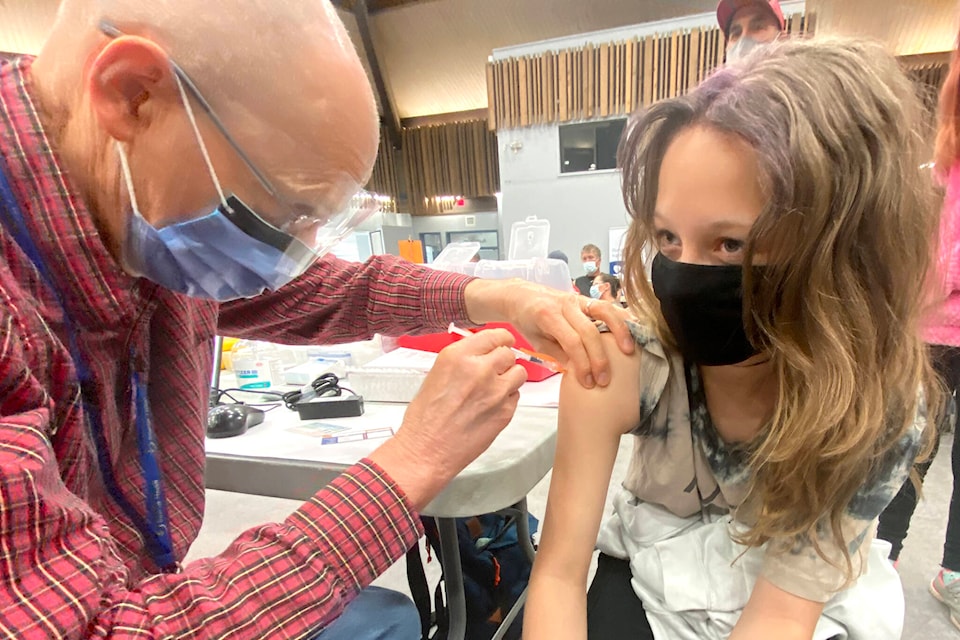The majority of children in the Interior Health region are not protected against COVID-19 as youth vaccination rates remain the second lowest in the province.
Vaccines for children ages five to 11 have been available in B.C. since November 2021, but new data from the BC Centre for Disease Control (BCCDC) shows Interior Health’s overall vaccination rates trail the provincial and national averages.
Only 39 per cent of children ages five to 11 as of Oct. 23, have had one dose of the vaccine in Interior Health, which is the second lowest in the province behind Northern Health at 32 per cent.
Interior Health also includes the local health area with the least children vaccinated in B.C. Just 15 per cent of children in the Arrow Lakes area, which includes Nakusp, have had their first dose.
The national average for youth vaccination rates is 53.8 per cent as of Oct. 9, according to Health Canada, however, in B.C. only 51 per cent have had their first dose.
Dr. Sue Pollack, a medical health officer with Interior Health, said Tuesday the region’s vaccination rates for children need to rise. She believes parents remain hesitant about the vaccines, but doesn’t think there is widespread refusal among families to have children inoculated.
“Parents want to do right, they want to do the best thing by their child,” said Pollack.
“Although COVID vaccines are relatively new, I think it’s really important to provide this information that these vaccines for the younger age group have been very widely tested and provided to many, many children around the world. We see very few adverse events.”
Teenagers, meanwhile, have much higher vaccination rates in Interior Health, B.C. and Canada.
Health Canada reported that 83 per cent of the national population has had at least one dose as of Oct. 9. That rises to 89.7 per cent among 12-to-17-year-olds in Canada.
Eighty-three per cent of the same group have had one dose in B.C., while Interior Health trails at 73 per cent.
Pollack said she believes despite 12-to-17 year olds being minors, they are more capable of voicing a desire to be vaccinated which would account for the higher uptake.
Still, the low vaccination rate among children is disappointing but not discouraging for Dr. Devon Greyson.
Greyson, an assistant professor at the University of British Columbia’s School of Population and Public Health, studies how effective the promotion of vaccines is communicated to the public.
Although Greyson believes misinformation about vaccine safety has kept some children from being inoculated, they think there are other reasons for the relative lack of urgency.
Children, for example, are far less likely than adults and seniors to either be hospitalized or die from infection.
Of the 46,389 deaths related to COVID-19 in Canada, just 41 have included kids ages 11 and under, according to Health Canada. The median age of patient hospitalizations in B.C. meanwhile is 68, according to the BCCDC.
Data from BCCDC also shows that Multi-system Inflammatory Syndrome, which has been linked to COVID-19 cases in children and adolescents, has only been detected in 34 cases in B.C. since the start of the pandemic.
Greyson said the families may also not have had their children vaccinated because COVID-19 research is relatively new. By comparison, the measles-mumps-rubella-varicella and polio vaccines that have existed for decades are considered routine for infants in Canada.
What parents should be concerned about, Greyson said, is whether there will be long-term consequences to a COVID-19 infection.
“We don’t know yet if COVID will be like measles or polio viruses where you can get complications many years down the line after everything seems to be recovered. We just won’t know until 20 years from now, probably. Is there any sort of long-term risk of COVID infection like that for children especially? We don’t know.
“Just the lack of information that we have makes a lot of space for fear and misinformation.”
As hospitalizations have fallen in B.C., public health orders have also done away with most COVID-19-specific preventative measures in schools. Gone are visitor restrictions, changes to classroom layouts and mandatory masks.
Instead, the virus is now considered a communicable disease like the flu. In practice that means in-person learning, encouraging students to wash their hands, keeping windows open when possible and asking staff and students to remain home if they are sick.
Voluntary vaccinations against viruses such as Hepatitis B and chicken pox are made available to Grade 6 and 9 students at B.C. schools. Pollack said Interior Health has considered adding COVID-19 vaccines to school clinics, but for now, is asking parents to instead visit public health units.
Greyson worries there hasn’t been enough research to suggest a return to pre-pandemic school settings was a safe policy decision. Should the COVID-19 health protocols have stayed in place? Greyson doesn’t know.
“Right now it feels more like a values question than a question to which there is a clear, scientific answer that will work for the majority of people.”
READ MORE:
•
•
•
| tyler.harper@nelsonstar.com
Like us on and follow us on .




